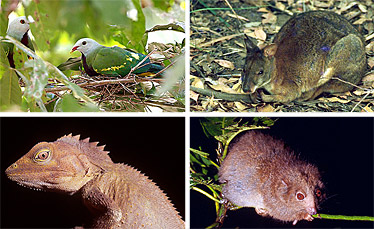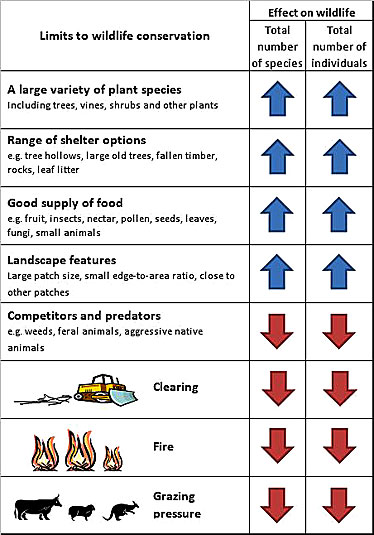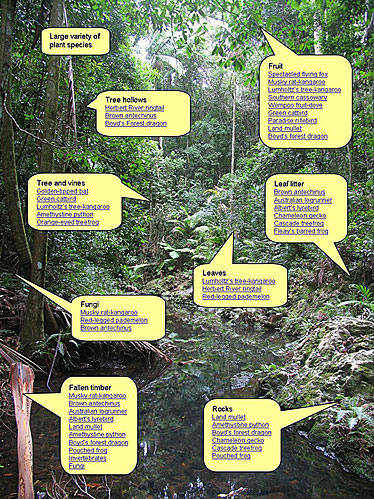Wildlife


Potential to conserve wildlife
Rainforest are famously diverse ecosystems. This diversity is apparent both in the number of plant and animal families and species supported, as well as the diversity of life forms represented. The biodiversity of Queensland's rainforests includes numerous rare species and many listed as threatened with extinction (e.g. the Nangur skink Nangura spinosa which is found in dry rainforest). Some types of Queensland rainforests are also listed as threatened ecological communities or endangered regional ecosystems.


Rainforests support ancient plant lineages such as the Kauri, Bunya and Hoop Pines (Agathis and Araucaria spp.), Bowenia spp., Austrobaileya scandens and Eupomatia spp. A typical hectare of rainforest will support more than 30 tree species, even in some drier rainforest types. Vines and epiphytes, including orchids, bryophytes and ferns, are also more common in rainforest ecosystems than any other vegetation type.
Mammals associated with dry and wet rainforest include the fawn-footed melomys Melomys cervinipes, bush rat Rattus fuscipes, red-necked pademelon Thylogale thetis and red-legged pademelon T. stigmatica. Tree-dwelling mammals found in tropical wet rainforest include the lemuroid ringtail possum Hemibelideus lemuroides, green ringtail possum Pseudocheirus archeri and Lumholtz's tree kangaroo Dendrolagus lumholtzi.
Many birds are associated with wet rainforest including the rose-crowned fruit-dove Ptilinopus regina and wompoo fruit-dove Ptilinopus magnificus, catbirds Ailuroedus spp., regent bowerbird Sericulus chrysocephalus, riflebirds Ptiloris spp. and the black-breasted button-quail Turnix melanogaster. Bird species frequently recorded from dry rainforest include Lewin's honeyeater Meliphaga lewinii, grey and rufous fantails Rhipidura spp., the fairy gerygone Gerygone palpebrosa and Australian brush-turkey Alectura lathami (note that another name for dry rainforest is ‘turkey scrub’).
Reptiles associated with wet rainforest include the skinks Eulamprus murrayi, E. tigrinus and Gnypetoscincus queenslandiae, and the southern angle-headed dragon Hypsilurus spinipes.
Australian rainforests (wet and dry) are also particularly rich in land snails.


Limits to wildlife conservation
Most management actions that will accumulate carbon in rainforest (such as excluding fire and grazing, and not clearing) will also benefit wildlife by reducing threats. The re-establishment of a closed canopy and the development of a mid-canopy and understorey are also very important for wildlife.
Habitat features that will help to conserve wildlife in rainforest include different types of shelter for wildlife, a good (and varied) supply of food, and the removal or control of weeds and feral animals. Landscape features, including the size and shape of habitat patches and their distance from each other, also have an influence on the potential of a site to conserve wildlife.


Habitat for wildlife
The tables below summarise key aspects of rainforests as habitat for wildlife, as sources of shelter and food, and as parts of living landscapes.
Shelter and food
| Feature | Benefits for wildlife | Used by |
|---|---|---|
| A large variety of plant species |
Conserves many plant species
Nesting, shelter, feeding and courtship sites Some animal species only feed on one plant species, or a small number of plant species A diversity of plant species flowering and fruiting at different times can provide a continuous food supply (e.g. fruit, nectar, pollen and insects) for animals |
Trees, vines, shrubs and epiphytes (air plants)
Birds, invertebrates, mammals, reptiles, frogs |
| Tree hollows, cracks and crevices | Shelter, nesting, a place to find food | Parrots, bats, gliders, small mammals, reptiles |
| Large old trees and fallen timber | Shelter, basking and feeding areas | Invertebrates, fungi, mosses, liverworts, lichens, birds, reptiles, frogs, mammals |
| Leaf litter | Shelter and feeding areas | Birds, invertebrates, reptiles, frogs, mammals |
| Rocks | Shelter, basking and feedings areas; habitat for plants | Invertebrates, reptiles, frogs, mammals, plants |
| Invertebrates | Food, pollination, seed dispersal | Birds, reptiles, frogs, mammals, plants |
| Fungi | Food, beneficial relationship with plants | Mammals, invertebrates |
Landscape features
| Feature | Benefits for wildlife |
|---|---|
| Large patch size |
Support larger populations of plants and animals
Support animals that need large territories and/or occur in low population densities May also support more species of wildlife |
| Small edge-to-area ratio |
Patches that are rounded in shape suffer fewer ‘edge effects’ than patches of a similar size that are long and thin
Edge effects include increased weed invasion, predation, wind, sun and temperature, and all of these can have important impacts on wildlife |
| Close to other patches |
Allows animals and plants to disperse between patches
Reduces the risk of predation for animals when they move between patches Improves the exchange of pollen between patches Species diversity tends to be greater in rainforest patches that are close to, or connected to other patches by corridors, than in more isolated patches |
| How much of the landscape is cleared |
Birds and mammals are negatively affected if more than 70% of the landscape is cleared of suitable habitat
A rainforest patch surrounded by intensive agriculture is likely to support fewer forest-dependent animals than one surrounded by a modified landscape that includes forest patches (e.g. a mosaic of crops and managed forests) There is also an interaction between grazing and how much of the landscape is cleared, as cattle tend to gather in the remaining patches of woody vegetation If most of a landscape, or vegetation type, has been cleared, any remnants are very important for wildlife conservation, even if they are small or in poor condition. These remnants may provide valuable source populations for restoring other parts of the landscape |
Threats to wildlife
| Threat | Impacts on wildlife | Wildlife affected |
|---|---|---|
| Weeds and feral animals |
Competition, predation
Some management actions to control weeds and feral animals can also have negative impacts on native species | Many different types of plants and animals |
| Exotic grasses |
Replacement of native plant species
Changes in habitat structure Increased intensity and frequency of fire | Plants, birds, reptiles, mammals |
| Grazing pressure | Can reduce shelter and food for wildlife by slowing and preventing the recruitment and growth of rainforest plants, and by trampling and reducing the amount of litter and fallen timber | Many different types of plants and animals |
| Clearing |
Removes many plant and animal species
Removes food and shelter for animals that depend on the plant species and structure found in rainforest | Many different types of plants and animals |
| Fire |
Many rainforest plant species have limited capacity to resprout after fire
Fire destroys features such as litter, fallen timber and hollows which are important for many animal species Fire is a major threat to the many species of land snails which are associated with rainforest | Many different types of plants and animals |


